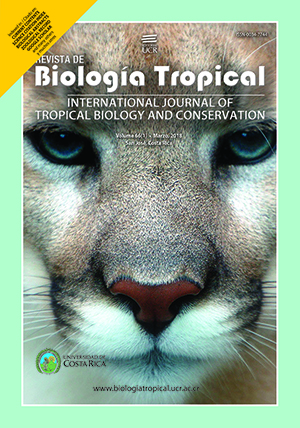Abstract
Guatemala, with 16 million inhabitants, is the largest economy of Central America and should have the largest scientific output of the region. To assess its productivity and impact, we analyzed the 3380 Guatemala articles included in the SCI-expanded in June, 2017. Most Guatemala documents are articles in English, deal with nutrition and health problems, and have a mean of 7.4 authors per article. Also in this particular database, citation lifespan is 40 years, and citations are higher for articles in English (twice more than those in Spanish), for reviews (mean 24 citations per review) and for studies resulting from international collaboration, which is done mostly with the USA and Mexico. The most productive institutions are the Center for Studies of Sensory Impairment CESSIAM, the universities of San Carlos and El Valle, and the Central American Nutrition Institute INCAP (but the INCAP has decreased productivity in recent years). The most productive researchers are N.W. Solomons, R. Bressani, L.G. Elías, C. Rolz and A. Cáceres. Guatemala represents a particular case in Central America because its high quality research is dependent on particular researchers rather than on institutions, and because the total output is well under the expectation. The productivity and citation of Guatemalan science in the 18 journals published in the country, and in other journals also not covered in the in the SCI-expanded, remain unknown. Nevertheless, the historical trend is positive, with a clear growth of international collaboration, productivity and citation.
References
Alonso, J. A. G., & González, Y. P. (2015). Análisis de las revistas latinoamericanas de Acceso Abierto. El caso Ecuador. Revista Publicando, 2(2), 12-23.
Blickenstaff, J., & Moravcsik, M. (1982). Scientific output in the third world. Scientometrics, 4(2), 135-169.
Braun, T., Glänzel, W., & Schubert, A. (1988). The newest version of the facts and figures on publication output and relative citation impact of 100 countries 1981–1985. Scientometrics, 13(5-6), 181-188.
Chuang, K. Y., & Ho, Y. S. (2014). Bibliometric profile of top-cited single-author articles in the Science Citation Index Expanded. Journal of Informetrics, 8(4), 951-962.
Chuang, K. Y., Wang, M. H., & Ho, Y. S. (2011). High-impact papers presented in the subject category of water resources in the Essential Science Indicators database of the Institute for Scientific Information. Scientometrics, 87(3), 551-562.
De Moya-Anegón, F., & Herrero-Solana, V. (1999). Science in America Latina: a comparison of bibliometric and scientific-technical indicators. Scientometrics, 46(2), 299-320.
Elango, B., & Ho, Y. S. (2017). A bibliometric analysis of highly cited papers from India in Science Citation Index Expanded. Current Science, 112(8), 1653-1658.
Fernández, M. T., Gómez, I., & Sebastián, J. (1998). La cooperación científica de los países de América Latina a través de indicadores bibliométricos. Interciencia, 23(6), 328-337.
Garfield, E. (1983). Mapping science in the Third World. Science and public policy, 10(3), 112-127.
Garfield, E. (1995). Quantitative analysis of the scientific literature and its implications for science policymaking in Latin America and the Caribbean. Bulletin of PAHO, 29(1), 87-95
Garfield, E. (2006). "The History and Meaning of the Journal Impact Factor". JAMA. 295 (1): 90–93.
Ho, Y. S. (2012). Top-cited articles in chemical engineering in Science Citation Index Expanded: A bibliometric analysis. Chinese Journal of Chemical Engineering, 20(3), 478-488.
Ho, Y. S. (2014). A bibliometric analysis of highly cited articles in materials science. Current Science, 107(9), 1565-1572.
Ho, Y. S., Kahn, M. (2014). A bibliometric study of highly cited reviews in the Science Citation Index Expanded™. Journal of the Association for Information Science and Technology, 65(2), 372-385.
Lewison, G., Fawcett-Jones, A., & Kessler, C. (1993). Latin American scientific output 1986–91 and international co-authorship patterns. Scientometrics, 27(3), 317-336.
Marini, A., & Gragnolati, M. (2003). Malnutrition and poverty in Guatemala. Washington, DC: World Bank.
Martinez-Folgar, K., & Salomon, V. M. (2017). Publicación científica estudiantil: un vistazo a la realidad guatemalteca. Educación Médica, 18(1), 79-79.
Monge-Nájera, J. (2014). The invalidity of the impact factor as indicator of the impact of Latin American scientific journals. Revista de biologia tropical, 62(1), 9-13.
Monge-Nájera, J., & Ho, Y. S. (2012). Costa Rica Publications in the Science Citation Index Expanded:: A bibliometric analysis for 1981-2010. Revista de Biología Tropical, 60(4), 1649-1661.
Monge-Nájera, J., & Ho, Y. S. (2015). Bibliometry of Panama publications in the Science Citation Index Expanded: publication type, language, fields, authors and institutions. Revista de Biología Tropical, 63(4), 1255-1266.
Monge-Nájera, J., & Ho, Y. S. (2017a). Bibliometrics of Nicaraguan publications in the Science Citation Index Expanded. Revista de Biología Tropical, 65(2), 643-655.
Monge-Nájera, J., & Ho, Y. S. (2017b). Honduras publications in the Science Citation Index Expanded: institutions, fields and authors. Revista de Biología Tropical, 65(2), 657-668.
Monge-Nájera, J., & Ho, Y. S. (2017c). El Salvador publications in the Science Citation Index Expanded: subjects, authorship, collaboration and citation patterns. Revista de Biología Tropical, 65(2), 657-668.
Monge-Nájera, J., Nielsen-Muñoz, V., & Azofeifa, A. B. (2010). Determinants of scientific output: an in-depth view of the productivity of tropical botanist and conservationist, Luis Diego Gómez Pignataro. Revista de Biología Tropical, 58(4), 1093-1114.
Pouris, A., & Ho, Y. S. (2014). Research emphasis and collaboration in Africa. Scientometrics, 98(3), 2169-2184.
Rojas-Sola, J. I., & Jordá-Albiñana, B. (2009). Análisis bibliométrico de las publicaciones Venezolanas en la categoría ciencias de la computación en la base de datos JCR (1997-2007). Interciencia, 34(10).
Sábato, J., & Botana, N. (1993). La ciencia y la tecnología en el desarrollo futuro de América Latina. Arbor, 146(575), 21.
Wang, M. H., Fu, H. Z., & Ho, Y. S. (2011). Comparison of universities’ scientific performance using bibliometric indicators. Malaysian Journal of Library & Information Science, 16(2), 1-19.
Comments

This work is licensed under a Creative Commons Attribution 4.0 International License.
Copyright (c) 2018 Revista de Biología Tropical







